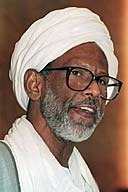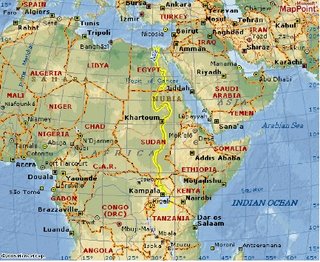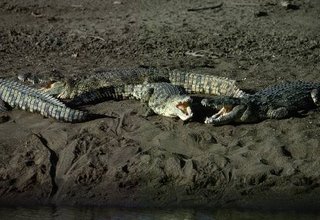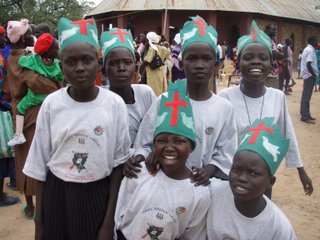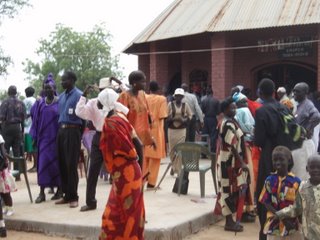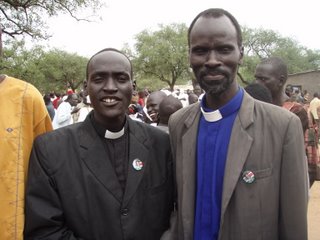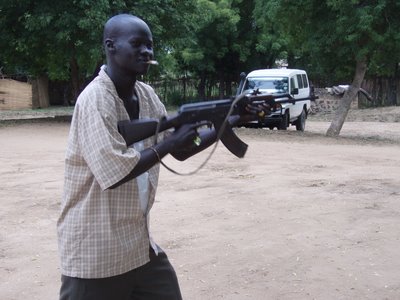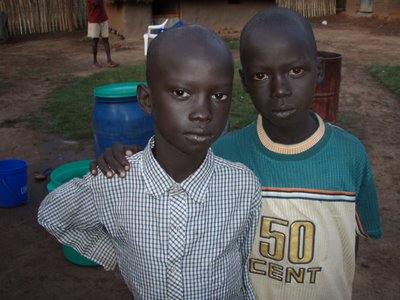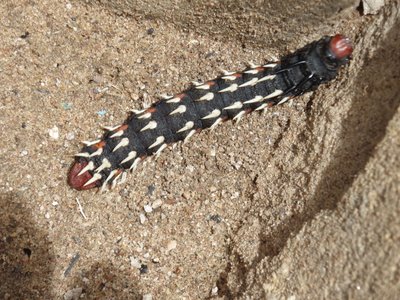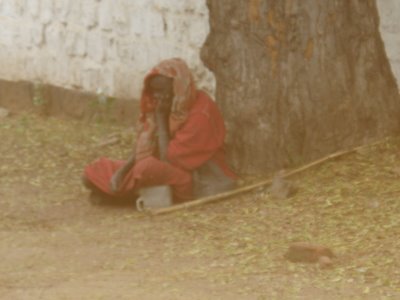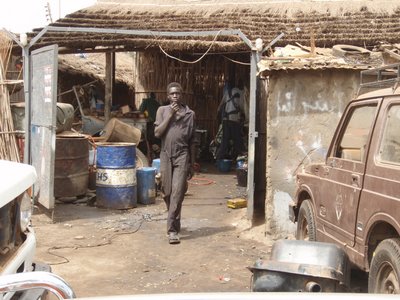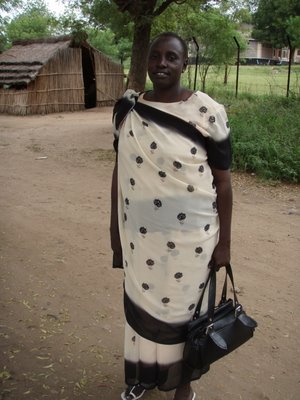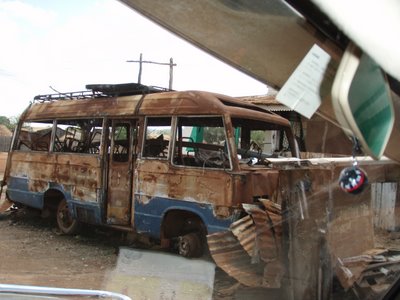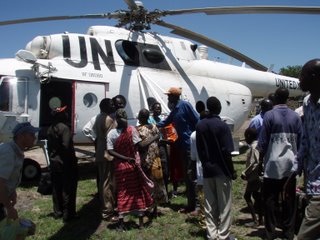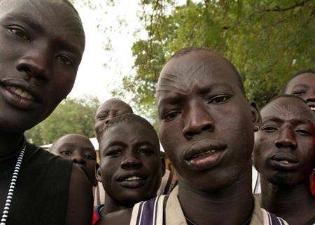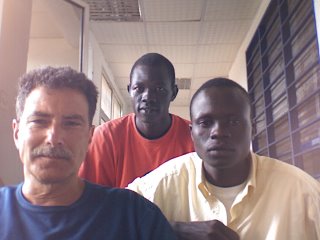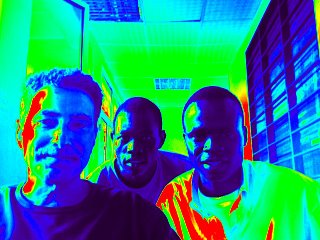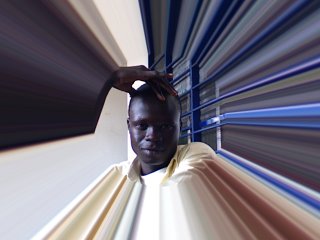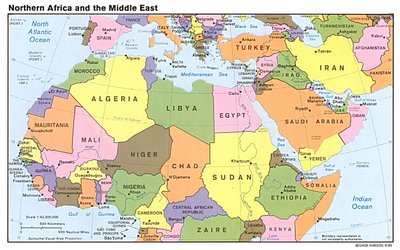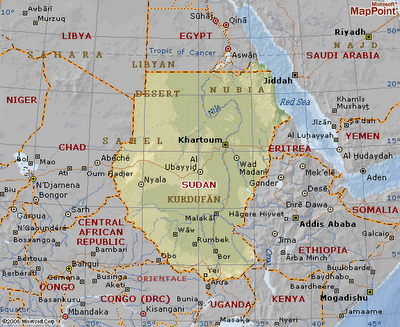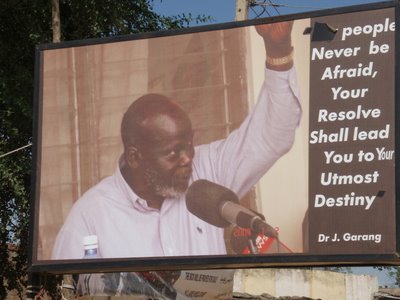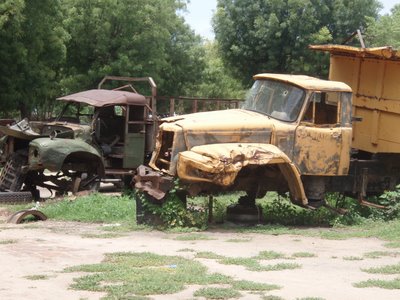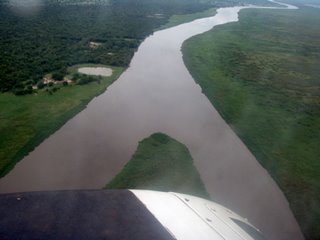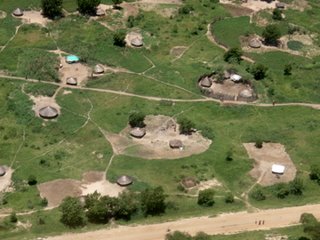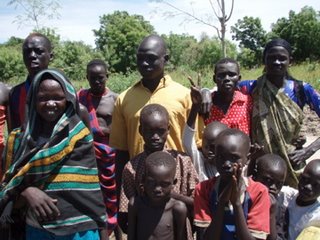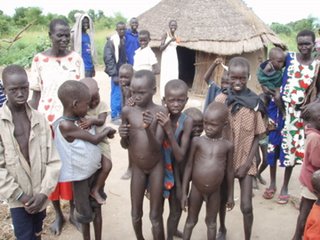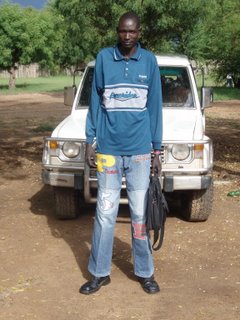
I spent my time almost exclusively with the Dinka. Until I did some reading and met other Africans in Uganda, my point of view of politics and history of Sudan was Dinka-centric. Most Americans have probably never come across a Dinka, though if you’re a basketball fan, you might remember Manute Bol or know about current NBA player Luol Deng. For you fashionmongers, supermodel Alek Wek may be your Dinka connection.

They are very dark-skinned, and generally lean – unless they are government ministers – in that case they have huge pot bellies. From my experience, they are a very gentle, kind, honest, respectful, and very generous. The only time I ever had saw an aggressive Dinka was when he was drinking. I believe I write about alcohol and the Dinka in the blog narrative somewhere.
They have their own language, thuongjang, which is written with Latin letters though with some variations on the Latin alphabet. In spite of the use of the Latin alphabet, the language itself bears to resemblance to either Germanic (of which English is included) or the Romance languages and was incredibly hard for me to make much headway. It’s also virtually impossible to find a Dinka-English dictionary or Dinka language book.
S
omething written in Dinka: Kënanyëköl ë Thuɔŋjäŋ, tënë raan wïc Thuɔŋjäŋ bë Kueen Adik ku lagöi ba tɛ̈n ëjɔɔk Thuɔŋjäŋ cök thïn dhiɛl ŋic; ku ye yïŋa kek ke lui thïn. Thuɔŋjäŋ acë lac jɔɔk tëmɛc apɛi, ala nin juëc ku kɔc cë luui thïn aa juëc, aa nɔŋ yiic kɔc ɣer ku muɔnyjiëëŋ.They treated me incredibly well – welcoming me into their homes and ensuring that I was safe They don’t appear to be an emotional people. Though they are constantly shaking hands, they rarely hug, and never kiss in public. It is common for men to hold hands when walking, though you will never see a man and a women doing the same. Actually, you don’t really see men and women walking together in town. Homosexuality “does not exist” in their world and don’t even try to insinuate that it does. Sex is simply not spoken about. I go into this a lot more at various points throughout this blog.
This being said, they are known to be fierce warriors and are very proud of their fighting and perseverance during the wars against the North.
Some of you have written to me asking for some background on the Dinka, so here it is:
So what’s up with the cows? This relationship between the Dinka and cattle seems to go back almost 5,000 years when they played a key role in introducing cattle to sub-Saharan Africa. After that, nothing would ever be the same for the Dinkas. I’m not sure what they were doing for the next 4,000 years, but since the 10th century they have inhabited an area on both sides of the White Nile, hence they are classified as one of the Nilotic tribes. (Check out the highly informative section on the Nile somewhere on this blog). By about 1500 AD, they had spread to their current location in Southern Sudan.
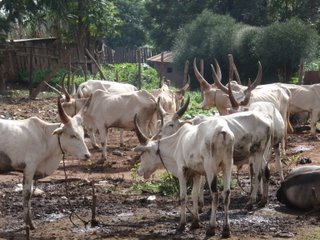
They are primarily pastoral - raising cattle, sheep and goat, though they have expanded into agriculture in some areas (and politics most recently – quite a natural evolution since bull shit is quite prevalent in both cattle raising and politics). Traditional homes are made of mud wall with thatched conical roofs and men will do the building.
Women do most of the farming, while men clear the forests in order to create farming areas. The boys tend the goats and sheep, while the men take care of the cows. As we’ve seen throughout this blog, cattle are central to every part of their life. Seriously, it’s all about the cows.
Though many men have only one wife, polygamy is considered the ideal for the Dinka. This was actually one of the hardest things for me to get my head around. Men can have as many wives as they can afford to support. There are legends of men with over a hundred wives, though I met no one who had more than a single-digit number of wives. Aduei’s grandfather, though, had over 20 wives which is why she has such a big family. From what I understood, the price of a wife is negotiated with the wife’s family and rarely goes below 30 cows. Once married, a wife is in essence, the property of the man and is treated as such. I asked many men how they can satisfy, both emotionally and sexually, their wives. They almost uniformly told me that to satisfy a wife is not their responsibility, but simply to provide her with children and enough food to raise the family.
I felt a certain detachment between the fathers and their children, especially since it is the women who are home with the children and raising them. This was exacerbated by years of war when fathers were gone for long periods of time fighting in the bush. In addition, due to the war, women make up 60% of the Dinka population and it would be impossible for every woman to get married if men could not take more than one wife..
Girls can be married off at quite a young age, though men often marry later since they first have to be established enough to provide the necessary cows. Families are dependent on the dowries brought in through marrying off their girls. These dowries allow the men in the family to marry – it’s sort of a closed circle.
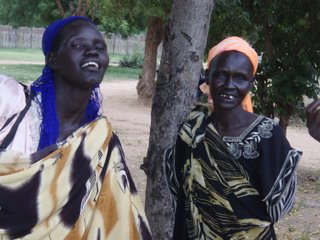
Though boys are much more highly valued than girls and are assumed to be smarter, the men are dependent on women for everyday sustenance. When I say that women do all the cooking, you must realize that cooking entails going to the river to get water, starting a fire, grinding the corn or grain by hand, going to the market or harvesting from the fields, and finally chopping, grating, mixing by hand and cooking over the fire - making sure that it stays properly stoked.
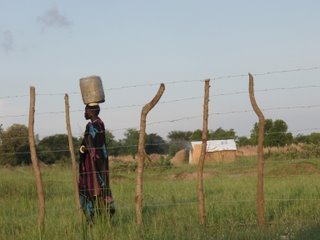
Then these same woman and girls must wash the plates and serve the men who are sitting around doing nothing and complaining that the food is not ready. I felt lie a radical feminist when I was in Sudan – strange, but true. Men claim that they would not know how to prepare a meal if their lives depended on it. I don’t quite believe it, since they managed to eat during all the years in the bush somehow.
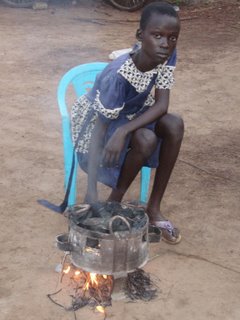
It was brought to my attention that even in certain parts of America, many women will marry for money and will live under the rule of a husband - cooking, cleaning and taking care of the kids. The major difference is that in Sudan, it is the parents who will decide who the girl will marry, regardless of her feelings. Many young girls are forced to marry older men as their third or fourth wife, even though they may be in love with a boy their own age.
The Dinka must marry outside of their clan, which is very tricky with polygamy. It seemed that whenever Aduei spoke long enough with anyone, she discovered that she was somehow related to him or her. Okay, not quite everyone. It could also be that many of the people we met, came to greet us due to the fact that they were relatives. In any case, it’s important for Dinkas to know their ancestry to prevent marrying someone from the family/clan. One of the advantages of this practice is similar to the marriage arrangements made by kings in the western world: marriages from another tribe can create alliances between two clans or tribes.
Now, you may wonder, how one traces their ancestry. The again, you may not. In any case, it was a bit confusing to me at first but here goes. The clans are traced along the male line. This makes it imperative for a man to marry and produce male offspring. They were shocked and I think quite embarrassed for me that I had only one daughter. They tried to convince me to take a young Dinka wife – or two - and produce sons so that my line will not die. Actually, being the only male Adler in my generation, has led to my relatives expressing similar reservations about my manhood and my failure to carry on the name. Just one of the many ways in which I’ve disappointed my family and had my manhood questioned. I didn’t let the Dinka know that I often cry at movies or AT&T commercials. Now back to the Dinka. A girl cannot preserve her family’s lineage, especially since her children will be brought up by and belong to her husband’s clan.
Ancestors are important to the Dinka and if you, Mr. Male, do not produce a son, you will never become an ancestor. (note shift from third to second person for no apparent reason at all). You have a future of oblivion waiting for you when you die. But all is not hopeless, as there are certain fail-safe precautions that may indeed save you. After you’re dead and decomposing, your brother or near relative can take a wife in your name and the children born will be “yours.” This gives new meaning to the concept of a deadbeat dad. But wait, there’s more. If you die before you had a son with your wife, this brother or close relative can take your widow as his wife and all children born to them will have your name.
There is one last option that I’m aware of. If, at some point during your wanderings from family to family, you took a detour and had an illegitimate son, you may claim the son with the fee of six cows. Six cows and he gets your name – or at least that’s what I understood.
I am assuming that the rigidity of this will all begin to break down as Dinka return from the West with “modern” ideas and with improved education and exposure to outside ways of life. There are already rumblings of women no longer wanting their husbands to have more than one wife. From the male side, there are many more educated or western-exposed men who will want only one wife. On the other hand, most young Dinka boys I spoke with are still hoping for a world with many wives, no cooking, and lots of sons. The clashes that so many cultures have gone through await the Dinkas. As of now, lip service is being paid to women’s rights, though when push comes to shove, there is a “not in my backyard” mentality. Sort of like the suburban liberals of the sixties and seventies.
There are somewhere between 2 and 3 million Dinka, making them the largest ethnic group in South Sudan. After the Arabs, they are the largest ethnic group in all of Sudan – the Arabs make up somewhere between 50-70% and the Dinka around 5-8%. As you can see, every statistic here is quite debatable. There has not been an honest census here since 1981, though one is planned for next year. There are constant accusations that the Arab North is always undercounting the Southern Black population – more on that in the History Section of this blog. Anyway, based on CIA figures, there are 41 million people in all of Sudan of which 52% are Black and 39% are Arab. Trying to find numbers that add up to 100% has been daunting, though not as bad as getting real numbers on total North and South populations. So let’s just leave it at that. The point is that the Dinka are the largest ethnic group in the South.
The Dinka refer to themselves as Moinjaang, though most that I met used the term Dinka – pronounced more like “Dinga.” The word “Dinka” means “person” for what it’s worth. They have no centralized political authority and have never had a king or queen. They are broken into clans, headed by chiefs, sometimes referred to as the “masters of the fishing spear.” Both the chiefs and the elders are treated with great reverence. Traditionally these chiefs serve as peacemakers and priests, though this is evolving with the integration of civil law – and is often some of combination of the two.
Their religion is covered in a separate section on religion. I never intended to have all these sections, but I get carried away.
Traditionally Dinka women would remove their bottom teeth as a symbol of beauty, but I only saw this on older women and this practice seems to have faded. Men still dye their hair red with cow urine, though the practice of scarring has not only been discontinued, but is illegal in Sudan. In the past, a boy’s initiation was marked by taking a sharp knife to the boy’s forehead and scariftying the boy with v-shaped marks or parallel lines. This would happen when the boy was between the ages of 10 and 16. These cuts are deep and skulls have been known to cut into the skull. This practice can be quite dangerous and kill the boy on occasion.
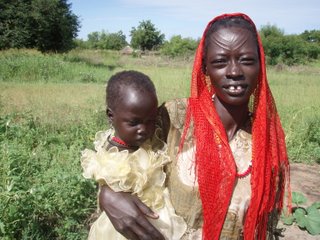
During the ceremony, the boy cannot flinch or scream. Doing this would bring disgrace to his family and ancestors and if he moved, a kink in the scars would be visible for the rest of his life and brand him a coward for all to see. And I thought that my bar mitzvah was tortuous.
Singing and poetry are still a big part of Dinka culture. There are different types of songs for each activity of life – from field work to special occasions to preparation for wart. I recorded some of these songs and if I can figure out how to upload them to the blog, you may listen to them. I heard men singing songs about their ancestors, war and peace, Dinka history, and anything else that came to their heads. They were a bit drunk when I recorded them, but there was fascinating dialogue going on between a lead singer who would create lyrical poetry while the others responded.
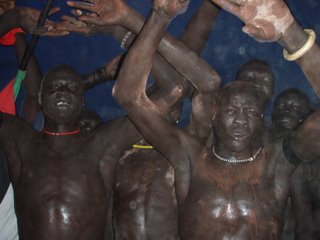
I understand that men often court women with songs about their many attributes. If the women likes the song, she may agree to meet the man privately to talk. I really wanted to see this in action, but did not get the opportunity.
Cows – let me count the ways in which you are significant. Cows play a role in religious practices. They are the highest form of sacrifice in ceremonies. They are also sacrificed to honor a person or guest, as was done for Aduei and I when we arrived to Yei. Cattle give milk and their urine is used for washing, to dye hair red, and in tanning hides. Cow dung is used to fuel the fires and the ash is used to keep the cattle clean, as body art, as well as for making a paste to clean teeth. I did not witness the latter use, but read about somewhere. Cattle are generally not killed for meat, but if one dies or is sacrificed, the meat is eaten and the hide is cured. The horns are used a wide range of practical and aesthetic items, though I’ve seen horns just lying in the road. The skins are used for drums, clothing, and mats.
Their culture fascinated me and it will be interesting to see what elements of their customs remain as they move into the modern era.
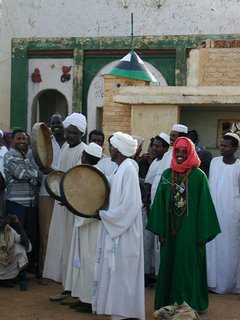
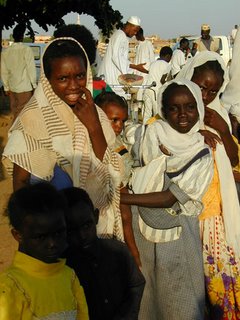
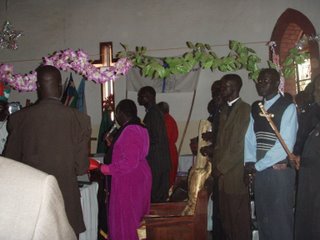
 Photo: Leper as seen through a car window
Photo: Leper as seen through a car window
